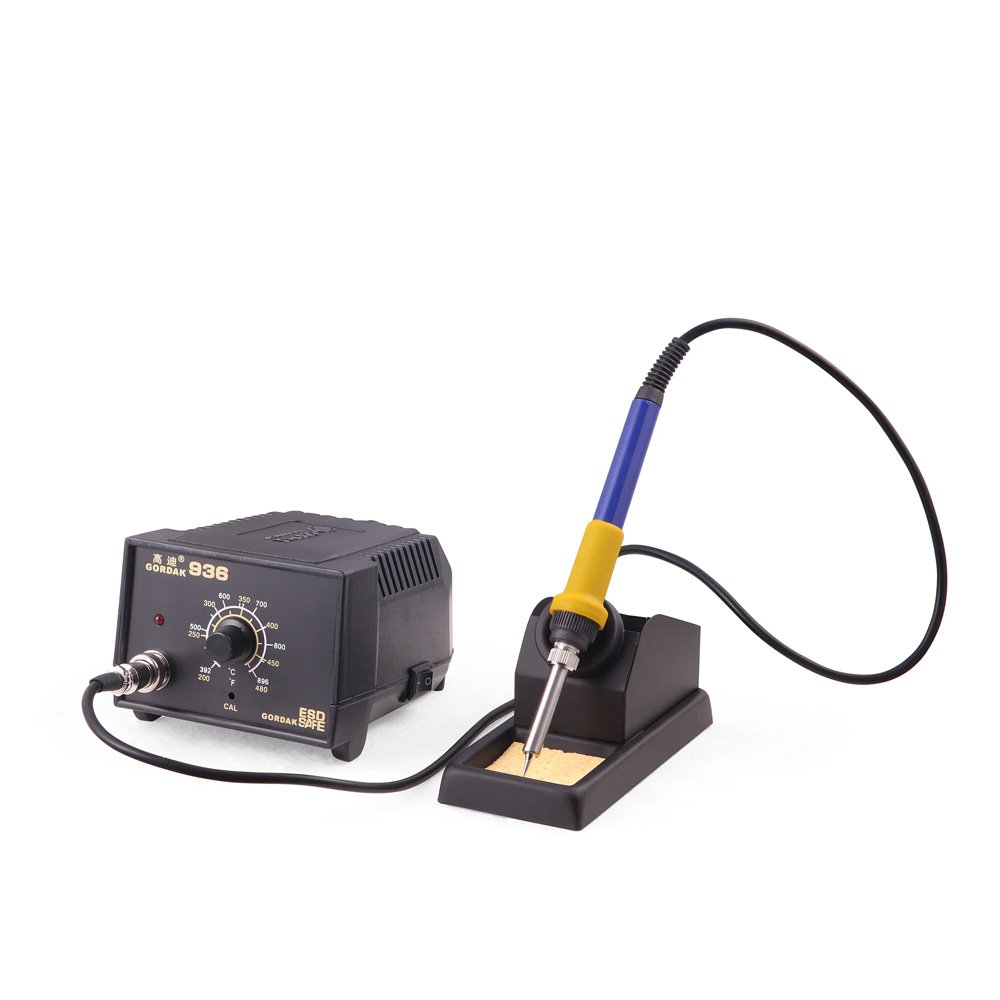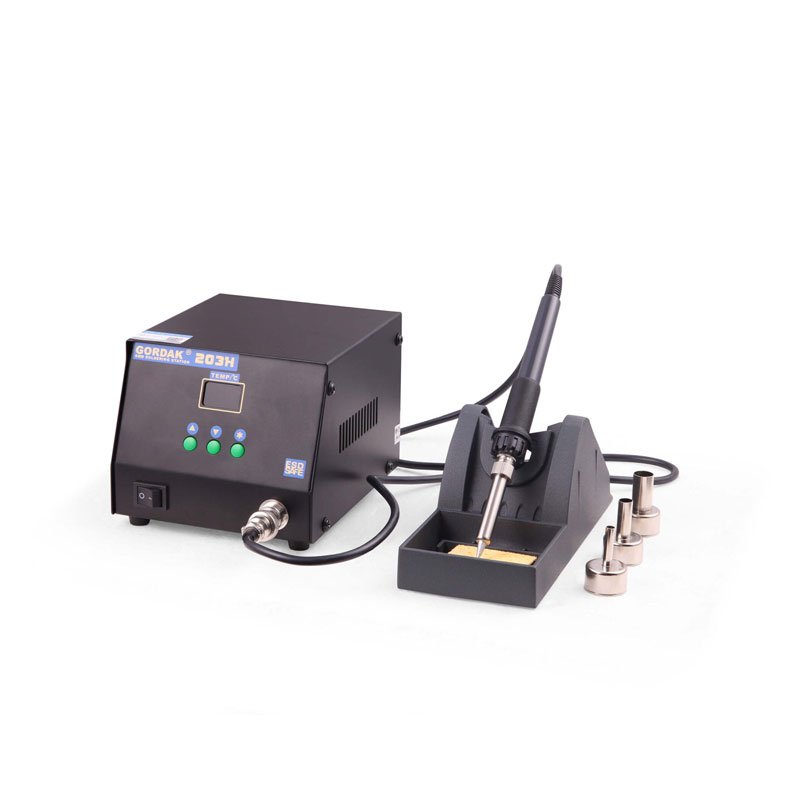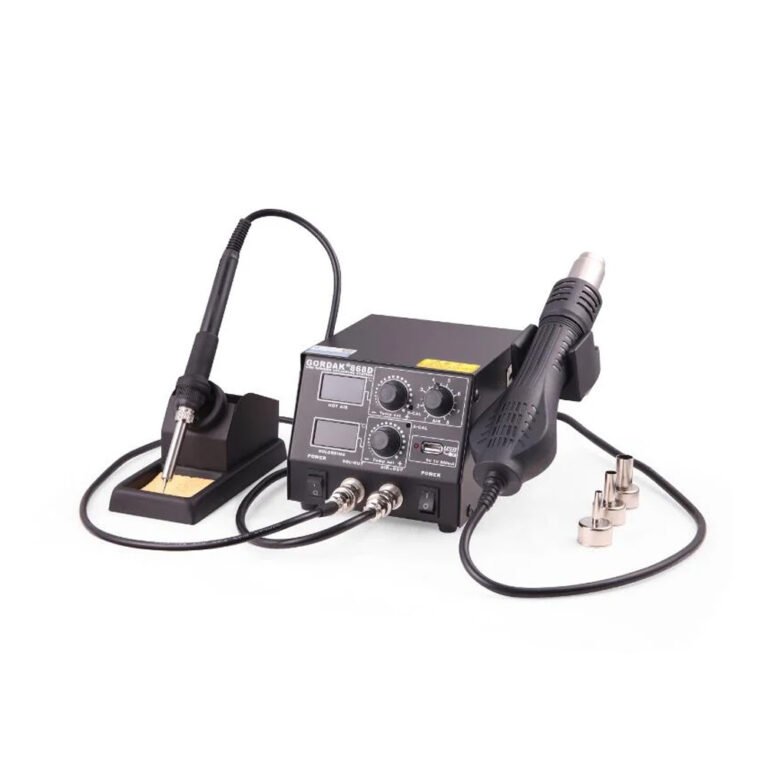Whether you’re a hobbyist, student, or electronics professional, a soldering station is a vital investment. Unlike basic soldering irons, soldering stations provide precise control, higher efficiency, and enhanced safety. But with so many models and features available, choosing the right one can be overwhelming. This guide will walk you through the essential considerations to help you make an informed decision.
1. What Is a Soldering Station?
A soldering station is an advanced soldering setup that typically includes:
- A base unit with adjustable temperature control
- A soldering iron with interchangeable tips
- A stand and tip cleaning accessories
Some models also integrate hot air rework tools, tweezers, or even DC power supplies, making them versatile for different applications.

2. Why Choose a Soldering Station Over a Soldering Iron?
Compared to a standalone iron, soldering stations offer:
- Precise temperature control for sensitive components
- Consistent heating without large temperature drops
- Better ergonomics and safety features
- Versatility with interchangeable tips and add-on tools
For electronics repair, SMD soldering, and professional use, a station is the clear choice.
3. Key Features to Look For
| Feature | Why It Matters |
|---|---|
| Temperature Control | Essential for avoiding overheating or cold joints. Look for digital or analog adjustable ranges. |
| Power Rating (Wattage) | Higher wattage (60W–120W) means faster heating and stable performance under heavy load. |
| Interchangeable Tips | Enables versatility—conical tips for fine work, chisel tips for larger joints. |
| ESD Safety | Protects delicate electronics from static discharge. |
| Hot Air Rework Option | Ideal for SMD/IC removal and reflow. Many stations offer a 2-in-1 solution. |
| Display & Controls | Digital displays are easier for accuracy, while analog dials are simpler and more affordable. |
| Build Quality | A durable iron handle, heat-resistant cord, and solid stand increase safety and lifespan. |
| Ease of Maintenance | Replaceable tips, heating elements, and filters keep long-term costs down. |
4. Types of Soldering Stations
- Analog Soldering Stations – Budget-friendly, controlled by a dial. Good for beginners.
- Digital Soldering Stations – More precise, with LED/LCD displays for accurate temperature settings.
- Hot Air Rework Stations – Used for SMD components, ICs, and reflow soldering.
- 2-in-1 / 3-in-1 Stations – Combine soldering iron, hot air gun, and sometimes tweezers or power supply in one unit.

5. Entry-Level vs. Professional Soldering Stations
| Feature | Entry-Level Station | Professional Station |
|---|---|---|
| Price Range | $40 – $120 | $150 – $500+ |
| Temperature Control | Analog or basic digital; less precise | Advanced digital with PID control; highly stable |
| Power Rating (Wattage) | 40W – 60W | 75W – 120W or higher |
| Heating Speed | Moderate (30–60 seconds) | Fast (10–20 seconds) |
| Temperature Stability | ±10°C | ±2–5°C |
| Tip Options | Limited selection, basic tips only | Wide range of specialized tips for SMD & micro soldering |
| Hot Air Rework | Rare; usually not included | Often built-in (2-in-1 or 3-in-1 stations) |
| ESD Safety | Sometimes missing | Standard feature |
| Durability | Adequate for hobby/light use | Built for continuous, professional use |
| Best For | Students, hobbyists, DIY repairs | Repair shops, engineers, professional technicians |
How to Decide?
- Choose an entry-level station if you are a beginner, doing occasional PCB or repair projects, and want an affordable starting point.
- Choose a professional station if you work daily on sensitive electronics, need high precision for SMD/BGA rework, or run a repair business.
6. Best Practices for Using a Soldering Station
- Always use the correct tip for the task.
- Keep the tip tinned and clean using a sponge or brass wool.
- Work within recommended temperature ranges (300–350°C for most electronics).
- Avoid unnecessary overheating—excessive heat damages components.
- Regularly check for wear and replace tips when needed.
Conclusion
A soldering station is more than just a tool—it’s the foundation of reliable electronics repair and assembly. By focusing on temperature control, safety features, and versatility, you can choose a station that fits your needs today and grows with your skills tomorrow.
About GORDAK
GORDAK is a leading manufacturer of soldering and rework equipment, providing high-quality, reliable, and innovative tools for electronics professionals worldwide. With over 30 years of experience, GORDAK specializes in:
- Advanced temperature control systems
- ESD-safe designs
- Durable soldering and rework stations for SMD and through-hole applications
Trusted across the globe, GORDAK combines innovation with affordability, making professional soldering accessible to all.
Contact: info@gordakelec.com
Soldering Stations: Usage, Selection & Maintenance
What Defines a Good Soldering Iron?
A Complete Buyer’s Guide to Soldering Stations
How to Properly Use a Soldering Station
Choosing the Right Soldering Station for Your Needs
How to Choose a Quality Soldering and Rework Station
Tips for Choosing the Right Choice of Soldering Station
How To Use A Soldering Station
The Best Soldering Iron of 2024: A Comprehensive Guide
Maintaining Your Soldering Iron: Best Practices



